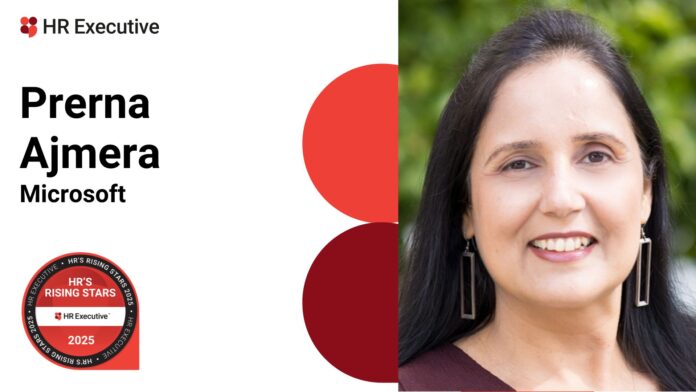Early in her career, Prerna Ajmera founded a start-up that built digital libraries of extinct languages—creating connections with scholars around the world, two decades before remote collaboration was a common reality. It was an experience that was both grounding and inspirational, she says.
“It taught me that innovation needs to be truly ahead of the curve—and it needs to solve real-world problems,” says Ajmera, general manager, HR digital strategy & innovation, Microsoft, and one of this year’s HR’s Rising Stars.
In her 19 years at the tech giant, Ajmera has leaned on those early-career lessons alongside her training as an architect—which helps her appreciate the need for aesthetically pleasing, yet functional, experiences—to center both user experience and operational effectiveness.
“Bringing joy and utility together in anything I do is inherent,” she says.
On the leading edge of AI innovation
Those aims were central to Ajmera’s work to develop and roll out an AI-powered Employee Self-Service Agent that leverages Microsoft Copilot within the company’s Dynamics 365 Customer Service system (D365).
Ajmera says the real-world problem was clear: Employees were navigating more than 70 HR tools, while HR teams were inundated with queries that often led to response times of up to two days—and an average of 4.5 days to close a ticket. The AI integration—now deployed to 60,000 Microsoft employees and eight private customers, with plans for general release at the end of this year—reduced support-ticket creation by nearly one-third and boosted IT self-help by 36%.
Related: Meet all of the HR’s Rising Stars for 2025
“From an employee feedback standpoint, it’s very quick, it’s grounded in reality and [employees] can trust it,” Ajmera says.
Ajmera also spearheaded the use of D365 Copilot to assist HR advisors with case research and documentation—leveraging the technology to summarize case history, offer research recommendations and draft communications, for instance.
The shift reduced case resolution time by 22%, while HR advisors have also reported a 16% increase in job satisfaction.
As case closure and case deflection rates improve, she notes, “HR teams can focus more on their human touch—rather than providing the same answers again and again.”
A streamlined approach to development
Ajmera also looked to AI to transform Microsoft’s approach to career development, seeking a more “unified” approach to skills development, career pathing and relocation support.
Through the Microsoft Career Hub, launched earlier this year, employees can now explore career paths personalized to their experience and skills profiles, as well as access learning and development opportunities. The platform is integrated with resources like Viva Skills and Viva Learning, Eightfold and LinkedIn. At the same time, Ajmera spearheaded the implementation of Sirva Mobility—integrated with the Employee Self-Service Agent—reducing relocation costs from $33,000 per employee to $22,000.
The streamlined strategy for career development and mobility is projected to save Microsoft $55 million annually.
Traditionally, Ajmera says, employees’ vision for their future with the company—and the potential for exploring opportunities in new geographic locations—was limited to their respective network or the guidance from their manager.
“Having that broader company view is giving us answers we may never have ever thought about,” she says. “[The tech can tell employees,] ‘You can go here or here vertically and progress in your role, or go into marketing or sales or industry solutions.’ ”
Creating holistic experiences and “enabling global citizens who can thrive in their careers while loving where they are is at the heart of why we are bringing these aspects together,” she says.
Marrying HR and tech capabilities
Ajmera’s titles at Microsoft reflect her dual proficiencies as an HR and a tech professional.
“I would say I’m bilingual,” she laughs.
Ajmera speaks “HR’s language of people” and the “tech language of systems,” and she has increasingly understood how to integrate those capabilities. She spent the early part of her career with Microsoft in content and product development, moving into more HR-facing roles about a dozen years ago—but always with a tech focus: While on the global compensation team, for instance, she built an industry-first performance product and a total rewards platform that was credited with reducing attrition by 3%.
As tech increasingly underlies HR’s work, she says, people professionals need to remain cognizant that tech shouldn’t be deployed “for the sake of tech.” Ajmera’s broad experiences across Microsoft’s HR functions, she says, helped her keep the people and business needs top of mind as she pioneered tech innovation.
Connecting tech capabilities with HR uses
Now, as AI proliferates, it’s more critical than ever for HR to not only be fluent in the languages of HR and technology—but also understand how to create a common language. Otherwise, they’re going to be left “sitting on a horse with a steering wheel,” she says.
“We’ve been doing things in a particular manner, but we’re being given these new tool sets. Unless you can talk to tech people so they can maximize what the tool can do for people, and talk to HR people about how they can really use the tech, you can’t bridge the gap,” she says.
To do that, HR has to understand the business needs, the HR problems, the pain points employees are experiencing, the technology available to solve those problems and the ongoing maturity needed for those tools to keep up with rapidly changing environments.
“I feel like I sit at the confluence of all of these, with the depth of my understanding and how I translate these visions and bring them to life,” she says.
Reaping the rewards of AI in HR
As she becomes a leading voice guiding AI’s integration into HR at Microsoft, Ajmera finds the responsibility “incredibly exciting.” Products or processes that used to take a year to develop are now being rolled out every month.

“We are charting these new territories, and every day we are making history for how HR will be done going forward,” she says.
That’s not to say the work isn’t daunting. From navigating questions around employee data to making “critical decisions” that can impact employees’ careers, Ajmera understands the “weight of the responsibility to get it right.”
To that end, she works closely with responsible AI experts to embed ethical principles into how Microsoft approaches AI integration—from the outset.
“It’s not like I build something, throw it over the fence to my responsible AI professional and say, ‘Go check on my work,’ ” she says. “No, building all of that at the earliest and having that empathy rooted in our HR professionals’ mindsets is how we think about it.”
See also: Microsoft’s recommendation for HR leaders: Get ready for ‘agent bosses’
Seeing the fruits of that labor is encouraging, she adds. Employees have commented that it took just seconds to get an answer to an HR question, or they received a verification letter in minutes, as opposed to five days, which allowed them to get approved for a mortgage.
Can talent transformation become a product feature?
“Having those moments come through is exciting and incredibly motivating,” Ajmera says. “We’re making employees’ lives easier. I feel very grateful for the unprecedented role that I’m getting to play here at Microsoft.”
Dayana Falcon, senior manager, HR Marketing & Engagement, at The Walt Disney Company—one of the 2024 HR’s Rising Stars and a judge for this year’s competition—says Ajmera is “redefining what it means to lead in the age of digital HR.”
“Her innovative use of the latest technological tools to drive talent mobility and speed to market is a masterclass in strategic execution and personalization,” she says. “What truly sets her apart is how she’s embedded HR impact with innovation into Microsoft’s technology stack, making talent transformation not just a function, but a product feature. A rising star, indeed—with results to back it up.”
It’s time to ‘think differently’ about HR leadership
As AI advancements accelerate HR into an even more strategic role, Ajmera says, people professionals need to lean into both “leading and learning.”
She spends significant amounts of time talking about AI advancements: with her team, Microsoft’s employees, C-suite leaders and customers, alongside her peers, mentors and leaders in the industry—learning what’s working and not on their respective journeys with AI in HR. At the same time, she frequently speaks at conferences and forums, sharing Microsoft’s experiences.
“It’s a two-way street,” she says.
Chris Fernandez, Microsoft’s chief HR AI officer and corporate vice president of HR, wrote in Ajmera’s HR’s Rising Stars nomination that her insights have shaped “product roadmaps, vendor strategies and industry conversations, ensuring that innovation remains grounded in real human needs.”
Ajmera’s work, Fernandez wrote, “has inspired teams across functions to think differently about what HR can be.”
Creating ‘HR in a pocket’ amid the AI in HR revolution
For Ajmera, that future vision of HR is a bright one. In a recent conversation with a CHRO, she says, the leader mentioned how they wished they had an HR professional available for every single employee to deliver the coaching, guidance and support the entire workforce needs.
“And that’s what AI is now able to do; we were joking it’s like ‘HR in a pocket,’ ” Ajmera says.
That capability will transform the perspective of the HR function. No longer will HR be looked at “as the police,” Ajmera says, but rather as the “value-adding” thought partner to the baseline support already provided by AI.
That will require a “real shift” in the HR profession, with a new emphasis on human-centric leadership, she says.
“We have to use all the resources that have been made available to us and be that creative HR professional helping the business grow and helping employees maximize their potential,” she says.
The vantage point from which she personally will do that isn’t clearly defined, Ajmera notes. She came into HR in a “very non-traditional” way and is envisioning a career path that continues to wind—around how she can shape the future of a function, energize her own passions and continue to learn, grow and “break new ground.”
No matter what that path looks like, Ajmera says, she plans to “stay true to my core mission, which is, how do I innovate and empower people? I want to continue to make a positive impact at a large scale.”
Ajmera and the other 2025 HR’s Rising Stars will be honored during the inaugural HR Icons Awards Evening, taking place Sept. 15 at Mandalay Bay in Las Vegas as part of the HR Tech conference.



